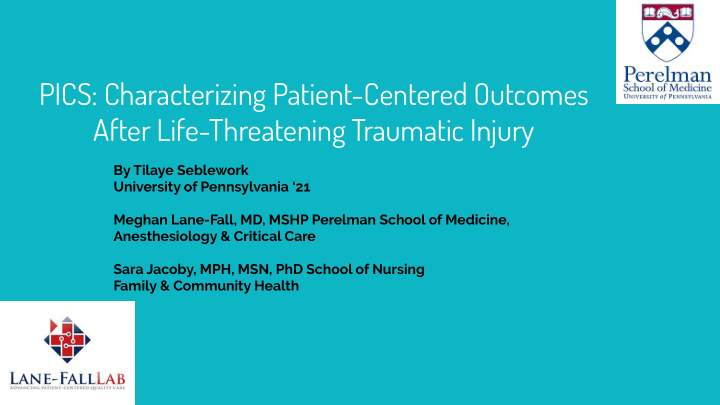



PICS: Characterizing Patient-Centered Outcomes After Life-Threatening Traumatic Injury By Tilaye Seblework University of Pennsylvania ‘21 Meghan Lane-Fall, MD, MSHP Perelman School of Medicine, Anesthesiology & Critical Care Sara Jacoby, MPH, MSN, PhD School of Nursing Family & Community Health
Background and Project Overview 2
What We All 3 PICS An emerging phenomenon which manifests itself in ICU patients and their families
4 Characteristics of PICS Post Intensive Care syndrome: New or worsening impairments in physical , cognitive , or mental health status arising after critical illness and persisting beyond acute care hospitalization Source: Needham, D. M., Davidson, J., Cohen, H., Hopkins, R. O., Weinert, C., Wunsch, H., ... & Brady, S. L. (2012). Improving long-term outcomes after discharge from intensive care unit: report from a stakeholders' conference. Critical care medicine , 40 (2), 502-509.
ASR: Acute Stress Reaction PTSS: Post Traumatic Stress Syndrome Source: https://www.aftertheicu.org/what-is-pics 5
5,ooo,ooo 6 Annual ICU admissions 20%-40% Require mechanical ventilation 3.8 days Average length of ICU stay Source: https://www.sccm.org/Communications/Critical-Care-Statistics
Despite increasing age and severity of illness, there was a 35% decrease in mortality for ICU admissions between 1988 and 2012 Source: https://www.sccm.org/Communications/Critical-Care-Statistics ” 7
PICS and Traumatic Injuries Trauma patients are a subset of ICU patients ● Traumatic Injuries are a major public health issue and the ● 4th leading cause of death in the U.S. Traumatic Injuries are a leading cause of disability in the ● U.S. PICS is severely under-researched in trauma patients ● Source: http://www.aast.org/trauma-facts 8
Significance of the Study Lay the foundation for future studies by shedding light onto the experiences of trauma patients and their families afuer ICU survival ” 9
10 Project Aim Primary Aim To elicit themes about patient-centered outcomes related to post-intensive care syndrome (PICS) during recovery from life-threatening injury
11 Project Design This PICS study is a mixed methods longitudinal study which follows 13 trauma injury patients and their families for a year after they have left the critical care unit
12 Methods Aimed to recruit 48 and retain ● 12-15 patients from a level 1 trauma recovery center Retained 13 dyads ●
Methods 13 Inclusion Criteria Exclusion criteria Older than 18 Discharge into long-term ▹ ▹ English fluency acute care facility ▹ Able to speak Police custody ▹ ▹ 48 or more hours of Unable to interview within an ▹ ▹ mechanical ventilation hour of Philly Patients of the PI ▹
Quantitative Analysis 14 Patients underwent neurocognitive testing to identify the ▹ objective extent of the patient’s Neurocognitive impairments if any Findings were input into RedCap and analyzed ▹
Qualitative Analysis 15 Interviews (7 over 1 year) ▹ In ICU At discharge 1 week 1 month 2 months 6 months 12 months Interview Structure ▹ 1-2 hours ▸ At hospital, rehab, and home ▸ Three portions ▸ Neurocognitive testing (10 mins) ⬩ Patient and family had separate interviews (30 mins - 60 mins) ⬩ Patient and family together (10 mins - 15 mins) ⬩ Transcriptions and coding ▹
16 Our Participants
17 Excerpts from Interviews Cognitive changes Emotional changes Physical changes “I’m noticing that there are times “ I'm always aware of my “Everybody got to feed me. They that I don’t remember things people surroundings and stuff like that. But got to bathe me. There’s so much. I tell me happened just a day or two sometime I get like nighttime around feel like I’m a baby all over again. ago more often. And if I do the same time where when I did get Really, I feel like I’m a baby all over remember, it’s not like I really shot, and I be feeling like the same again. They got to bathe me, feed remember it. It’s vague. I don’t – presence: Like, if I see somebody or me, make sure everything all right and this is very immediate, day see anything moving, I always get with me every couple minutes” before kinda thing. So I notice that. like that fear that I had that same day ~ P005, Interview 5 I notice that my memory feels like – I was there. And it just could be I’m not retaining things when they anywhere, but it just like the same happen. I don’t – people are like time of night, I don't even try to be you were there. How could you not outside. If it's like bed, that's like my remember that you were in this number one warning sign. Every building and I’m like I don’t know time it start hitting dark, I just come what you’re talking about. So I’m right back inside the house because I having problems with memory.” just ... I don't know. I'm just scared to go out there now…” ~ P016, Interview 3 ~P003, Interview 6
Preliminary 18 Findings/Emerging Themes ICU transitions are often jarring ▹ Patients expressed PICS at different ▹ timepoints Losing independence is frustrating ▹ Positive change can appear in the face of ▹ adversity
19 Next Steps Wrap up data analysis ▹ Summarize findings ▹ First draft for manuscript ▹
My Role 20 Coded interviews using Nvivo ▹ Aided in the review of existing literature ▹ Aided in the drafting of the manuscript ▹ Attended team meetings ▹ Shadowed mentor in ICU rounds ▹
Lessons Learned 21 Qualitative research is not easy ▹ Appreciate the people who invest in you ▹ Qualitative coding skills ▹ Confidence ▹ Holding yourself accountable ▹
Acknowledgments 22 Meghan Lane-Fall, MD, MSHP Sara Jacoby, MPH, MSN, PhD Chris Koilor Joanne Levy, MBA, MCP Safa Browne Ashley Anumba SUMR 2019
Recommend
More recommend